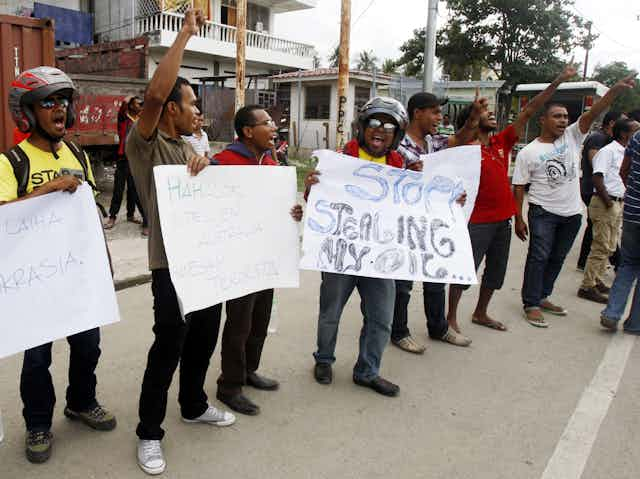In recent years, disputes over the resource-rich Timor Sea have consumed bilateral relations between Timor-Leste and Australia.
The Timor-Leste government’s key goal is to settle permanent maritime boundaries. In its view, a “fair” settlement would mean expanding the current eastern lateral line so Timor-Leste would control all of the lucrative Greater Sunrise oil field.
This is ambitious and unrealistic. To win control over Greater Sunrise, Timor-Leste would need either to convince Australia to draw the lateral lines according to its view, or to persuade Australia to submit to international third-party arbitration.
Both of these options are unlikely. Any maritime boundary will need to be settled by negotiation. This would mean compromising on the Greater Sunrise field.

Timor-Leste’s approach
In 2002, Australia withdrew from the relevant international third-party bodies that are tasked with arbitrating maritime boundary disputes.
Timor-Leste has two key strategies to deal with this. The first is a unified public diplomacy campaign designed to pressure Australia. With the support of Timorese and Australian advocates, the government has sought public attention and support. It has framed the issue as being about sovereignty and Timor-Leste’s right to maritime boundaries, rather than resource distribution.
The campaign also presents the Greater Sunrise field as belonging to Timor-Leste under international law. But the notion that it is Timor-Leste’s sovereign entitlement is misleading. If, hypothetically, Timor-Leste did convince Australia to submit to third-party arbitration, it would need to prove the eastern lateral line should be altered.
Timor-Leste’s success is not assured. It, like Australia, has a claim to the Greater Sunrise field. Altering the eastern lateral line would affect Indonesia’s maritime territory and almost certainly position Indonesia as a third claimant.
The second strategy is to use international courts and conciliation processes. But these cannot force Australia into third-party arbitration. Their use should instead be regarded as another form of pressure.
Australia’s approach
Timor-Leste is one of the world’s most oil-dependent countries. Oil revenues provide approximately 95% of the state budget. One monitoring organisation suggests the oil from the Joint Petroleum Development Area will be depleted by 2020 and Timor-Leste’s petroleum wealth fund will last until 2025.
The oil revenues from Greater Sunrise are vital to the Timorese state’s survival. Resolving this issue is urgent for Timor-Leste, and the lack of time only intensifies its vulnerabilities.
Australia, in contrast, does not desperately rely upon a resolution.
Australia takes a realpolitik approach to foreign policy, defined primarily by the pursuit of the national interest. Timor-Leste would need either to convince Australian to act outside of its national interest or change its perceptions of its national interest. In doing the latter, Australia would be abandoning four decades of bipartisan policy.
Continuity rather than change is a dominant feature of Australian foreign policy. This makes history useful when trying to predict Australia’s behaviour.
All of Australia’s maritime boundaries have been negotiated. Timor-Leste would need to persuade Australia to change its preferred method of settling permanent maritime boundaries.
Australia’s approach to the Timor Sea has also been consistent across four decades, irrespective of changing governments. Australia supported Indonesia’s occupation of East Timor because the government had interests in Timor Sea oil, as reflected in the 1989 Timor Gap Treaty with Indonesia.
While Australia ultimately supported Timorese independence in 1999, this policy shift was not a result of civil society pressure. It was due to Indonesia’s own move toward granting special autonomous status.
A weak Timorese state is not in Australia’s national interests. But, for four decades, territorial and corporate considerations have primarily defined interests in the Timor Sea. Australia also does not necessarily see oil revenues as solving Timor-Leste’s pressing social, economic or political challenges.
Labor has offered a “new maritime deal”. But, ultimately, oppositions are not governments.
What does the Timor-Leste government really want?
The Timor Sea dispute is a significant public issue in Timor-Leste. Escalating rhetoric serves the useful political purpose of distracting civil society organisations and citizens from domestic problems – including uneven resource distribution, poor governance and corruption.
Timor-Leste and Australia could settle permanent maritime boundaries, but they would have to negotiate. The most likely arrangement is that Greater Sunrise would be divided between Timorese, Australian and possibly Indonesian territory. The consequence of uncompromising rhetoric is that any deal that fails to give Greater Sunrise to Timor-Leste will be domestically unpopular.
This approach undermines the most realistic pathway to resolution: negotiation. In terms of what is achievable, any foreign policy approach that does not account for strategic and historical realities is likely to fail.

